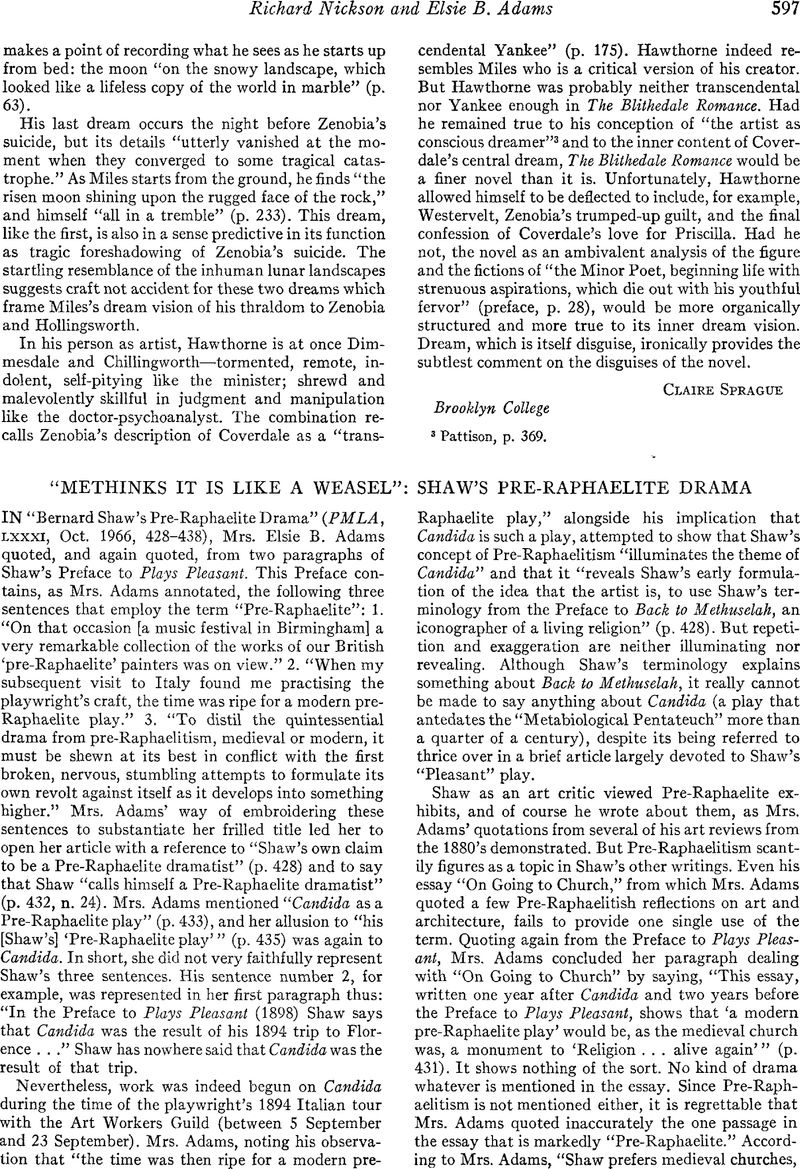No CrossRef data available.
Article contents
“Methinks it is Like a Weasel”: Shaw's Pre-Raphaelite Drama
Published online by Cambridge University Press: 02 December 2020
Abstract

- Type
- Notes, Documents, and Critical Comment
- Information
- Copyright
- Copyright © Modern Language Association of America, 1969
References
1 Selected Non-Dramatic Writings of Shaw, ed. Dan H. Laurence (Boston, Mass., 1965), p. 384.
2 Writings, p. 389.
3 Archibald Henderson, George Bernard Shaw: Man of the Century (New York, 1956), p. 544.
4 Henderson, p. 435.
5 Henderson, p. 544.
6 “Modern Religion,” Platform and Pulpit, ed. Dan H. Laurence (New York, 1961), p. 118.
7 Complete Plays with Prefaces (New York, 1962), iii, 747.
1 All my references to the Preface to Plays Pleasant and Candida are from the Constable edition (London, 1931).
2 I suppose it is this literalism that prompts Mr. Nickson to object to my footnote listing Androcles as a play with a medieval setting. Strictly speaking (in the mode of Mr. Nick-son), one ought to distinguish (in an essay devoted primarily to distinguishing such concepts) a series of temporal-artistic periods like Early Christian, Late Christian, Early Medieval, Medieval, Late Medieval, and so forth; but I chose to use more generalizing terms, e.g., Medieval, Renaissance. It is worth noting that some books on medieval art include Early Christian art and that Rossetti referred to the P.R.B. as “Early Christian” (Holman Hunt, Pre-Raphaelitism and the Pre-Raphaelite Brotherhood, i, New York, 1905, 140).
3 In Our Theatres in the Nineties, ii (London, 1932), 209–216; Pen Portraits and Reviews (London, 1932), pp. 201–210; and Platform and Pulpit, ed. Dan H. Laurence (New York, 1961), pp. 130–144.
4 See, e.g., Shaw's comments on medieval art on pp. 381, 383, 386, in “On Going to Church,” Selected Non-Dramatic Writings of Bernard Shaw, ed. Dan H. Laurence (Boston, 1965), p. 381. Future references to this essay are to this edition.
5 “My Way with a Play,” in Shaw on Theatre, ed. E. J. West (New York, 1958), p. 268.
6 Bernard Shaw: Collected Letters, 1874–1897, ed. Dan H. Laurence (London, 1965), p. 505.
7 Letters, pp. 623, 641. One letter was written 6 Apr. 1896, and the other, ca. 20–26 Aug. 1896.
8 Letters, p. 506.
9 Confessions of an English Opium Eater and Other Essays, ed. A. W. Pollard (London, 1924), pp. 63, 81.
10 “Modern Religion,” in Platform and Pulpit, pp. 129–130.
1 New York, 1936, p. 22. Cf. the telling passage about Morris and Pre-Raphaelitism in Shaw's letter, dated 11 Sept. 190S, to his biographer Archibald Henderson, in which the playwright described Morris' talking to him “about Whistler and the Impressionists in a way which showed that he knew all about them and what they were driving at, though before that I had given him up as—on that subject—an intolerant and ignorant veteran of the pre-Raphaelite movement” (Henderson, p. 181).
2 It has seemed useful to generations of historians to think of the Middle Ages as the period from the “fall of the Roman Empire” (395 A.D.) to the fifteenth century; that is, the middle years between Roman times and modern. Although Bernard Shaw was scarcely intent on writing a historical drama with his Androcles, the main scene is Rome, a prominent character is The Emperor, and Christians are being persecuted. Since legislation against Christians was removed from the Roman statutes by 313, the action of the play must be thought of as taking place no later than the opening years of the fourth century. The salient action of the comedy—the Christian persecutions—makes it impossible, for me, to think of Androcles as having a medieval setting. Yet it clearly is of a time subsequent to the birth of Jesus! Somewhere, Bernard Berenson has written, sagely enough, that categories are only a compromise with chaos. Mrs. Adams scorns such compromise, or “literalism.” Chaos is come again.
3 “Calling for ‘The Doctor’,” The New York Review of Books, 13 July 1967, p. 4.
4 “William Morris,” Pen Portraits and Reviews (London, 1949), p. 209.
5 Bernard Shaw: Collected Letters, 1874–1897, ed. Dan H. Laurence (New York, 1965), p. 466.
6 Plays: Pleasant and Unpleasant. The Second Volume, Containing the Four Pleasant Plays (London, 1898), p. 151. It is in this first edition that the singular listing—in the table of contents only—of “a Mystery” as subtitle appears.
7 Ellen Terry and Bernard Shaw: A Correspondence, ed. Christopher St. John (New York, 1931), p. 248.
1 Pre-Raphaeltiism and the Pre-Raphaelite Brotherhood, i (New York, 1905), 137.
2 For this reason I would, if I were writing an essay on Shaw's plays with medieval settings, include Androcles; it is certainly an example of “Early Christian,” if not, strictly speaking, “medieval” setting. My authority is Shaw, who echoed Ruskin's and Morris' division of art into three broad periods (classical, medieval, modern), using the Renaissance as the dividing point between medieval and modern and characterizing the Middle Ages as a period in which art reflected a vital religious consciousness.
3 William Morris As I Knew Him (New York, 1936), p. 52. Shaw saw in Ruskin an identical transformation; see, e.g., “Ruskin's Politics,” Platform and Pulpit, ed. Dan H. Laurence (New York, 1961), p. 131.
4 Our Theatres in the Nineties, ii (London, 1932), 210.
5 Mr. Nickson cites Shaw's statement that Morris' biographer Mackail “thinks of Pre-Raphaelite art as being ante-Victorian rather than characteristically Victorian, as of course it was.” In this passage Shaw implies no disapproval of Victorian art, which was, when Shaw wrote the review, “modern” art. Shaw is equating nineteenth-century Pre-Raphaelite art with “good Victorian art” and objecting to its being considered a reversion to the Middle Ages rather than modern (Pen Portraits and Reviews, London, 1931, p. 209).


